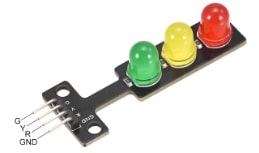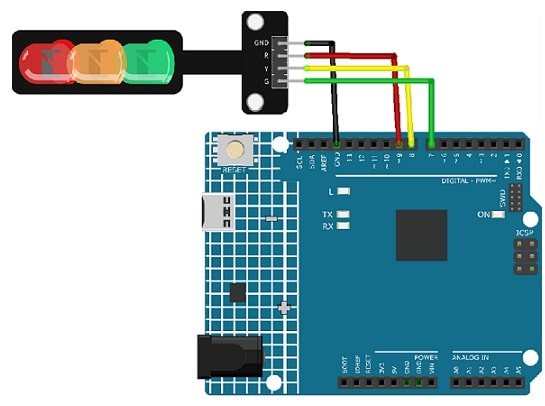The first traffic light (stoplights or traffic signals) was launched in December 1868 in London on Parliament Square to decrease the requirement of traffic police officers to control traffic. These systems use electricity & computerized control with superior traffic light technology and improved intersection capacity. This system can also be used for purposes like pedestrian movement control, railway level crossings, and variable lane control like smart motorways and tidal flow systems. These signaling devices are arranged horizontally or vertically at intersections of road and pedestrian crossings to control the traffic flow. Generally, these lights include three signals that transmit required data through symbols and colors (arrows and bicycles) for the public on the roads. This article provides brief information on an LED traffic light module, their working, and their applications.
What is an LED Traffic Light Module?
An LED traffic light module is a small electronic device that displays three colors similar to a standard traffic light: Red, Yellow, & Green. So this is an efficient and reliable solution for signaling & traffic control systems. This system can be integrated easily into different DIY and electronic projects, educational purposes, and traffic control simulations.
How Does the Traffic Light Module Work?
The traffic light module can be controlled in two primary ways. So, the simpler method uses digital inputs of the Arduino board, wherever a LOW or HIGH signal turns on or off the equivalent LED directly. On the other hand, the PWM (pulse-width modulation) technique can be used, particularly when changing the desired LED brightness. PWM is a method where the digital signal’s duty cycle can be modified to modulate the LED brightness. So, a duty cycle signifies the fraction of time that a signal stays on throughout a particular period.
Pin Configuration:
The LED traffic light module pin configuration is shown below. So this module includes four pins, which are explained below.

LED Traffic Light Module Pin Configuration
- Pin-1(GND): It is the ground pin of the module.
- Pin-2(R): This pin indicates a red LED.
- Pin-3(Y): This pin indicates a Yellow color LED.
- Pin-4 (G): This pin indicates a Green color LED.
Features & Specifications:
The features and specifications of the LED traffic light module include the following.
- LED traffic light module includes four pins.
- Its voltage rating is 5VDC.
- Its current rating is 30mA.
- LEDs are available in three colors: Red color, Yellow color, & Green color.
- It has normal brightness.
- It has a common cathode interface.
- Input is a digital signal.
- LED height & diameter are 10mm and 8mm.
- Its height x length x width is 14mm x 60mm x 20mm.
- This module is compact & durable.
- It has low power consumption.
- This can be integrated easily with microcontroller projects.
- It is used in versatile applications.
- Operating current when 5V is used is 13mA for a red light, 13mA for a yellow light, and 25mA for a green light.
- Its operating temperature ranges from -30℃ to +85℃.
- Its storage temperature ranges from -40℃ to +100℃.
LED Traffic Light Module Interfacing with Arduino
LED traffic light module interfacing with Arduino is shown below. It is a very compact & robust design that ensures ease of installation and durability in various traffic management applications. So, this traffic signal module provides an efficient & adaptable solution to implement current traffic signalization systems.
The required components to make this interfacing mainly include an Arduino Uno R3 or R4 board, a traffic light module, and jumper wires. So the connections of this interfacing follow as;

LED Traffic Light Module Interfacing with Arduino
- Connect the GND pin of the traffic light module to the GND pin of the Arduino board.
- Connect the pin-R of the traffic light module to the Pin-9 pin of the Arduino board.
- Connect the pin-Y of the traffic light module to the Pin-8 pin of the Arduino board.
- Connect the pin-G of the traffic light module to the Pin-7 pin of the Arduino board.
Code
The required code for interfacing the LED traffic light module with Arduino is shown below.
Pin numbers for each LED
const int rledPin = 9; //red
const int yledPin = 8; //yellow
int gledPin = 7; //green
void setup() {
pinMode(rledPin, OUTPUT);
pinMode(yledPin, OUTPUT);
pinMode(gledPin, OUTPUT);
}
void loop() {
// Green LED on for 5 seconds
digitalWrite(gledPin, HIGH);
delay(5000);
digitalWrite(gledPin, LOW);
// Blink yellow LED three times with intervals of 0.5 seconds
digitalWrite(yledPin, HIGH);
delay(500);
digitalWrite(yledPin, LOW);
delay(500);
digitalWrite(yledPin, HIGH);
delay(500);
digitalWrite(yledPin, LOW);
delay(500);
digitalWrite(yledPin, HIGH);
delay(500);
digitalWrite(yledPin, LOW);
delay(500);
// Red LED on for 5 seconds
digitalWrite(rledPin, HIGH);
delay(5000);
digitalWrite(rledPin, LOW);
}
Working
In the above code, the constants are defined for the pins wherever LEDs are connected. So this makes the above code easier to read & modify. The pin mode is specified for our LED pins. Thus, they all are set to OUTPUT as we intend to send voltage supply to them wherever our traffic light cycle logic is executed.
This code simply controls this module with an Arduino Uno board. So, the three LEDs are connected to pins 7, 8, and 9, respectively. This code sets the modes of the pin to OUTPUT after that, it runs a loop where it cycles throughout the traffic light model. Thus, the green color LED will be on for 5 sec, the yellow color LED will be on for 1.5 sec, and the red color LED will be on for 5 secs. So, this pattern repeats.
Advantages & Disadvantages
The advantages of LED traffic light modules include the following.
- The LED traffic light module has many benefits, like long lifespan, fast response, power saving, good visibility, etc.
- These modules generate less heat, less maintenance, improved visibility and security, versatility, customizability, etc.
- The LEDs in this module are far superior to fixed lighting.
- LED lights generate light only in the preferred colors.
- These are brighter because it is equally distributed across the whole surface.
- LEDs last up to 100,000 hrs because they don’t have filaments to exhaust.
- LED lights enhance traffic safety because they reduce the number of signal outages.
- These are economical to utilize with battery backup systems.
The disadvantages of LED traffic light modules include the following.
- Its initial cost is higher.
- Glare concerns:
- It has color consistency issues.
- These modules need specialized drivers to work correctly.
- Sometimes, LED light can lead to irregular illumination at the junction, mostly in conditions with difficult geometry.
- Upgrading the infrastructure of existing traffic signals & incorporating the modules into a combined system can be a major economic burden for a lot of cities.
- In addition, software vulnerabilities, cybersecurity threats, and technical glitches could potentially disturb the traffic light modules’ functionality.
LED Traffic Light Module Applications
The applications of LED traffic light modules include the following.
- Engineers mainly use an LED traffic light module within traffic signal systems at road intersections to control vehicle movement by displaying green, red, and yellow lights, ensuring security and efficient traffic flow.
- Its applications mainly include enhancing visibility at pedestrian crossings, regulating traffic at intersections, and improving visibility in bicycle lanes during difficult weather conditions.
- Many electronics projects incorporate it because of its simple design and effective control mechanisms.
- People use it at pedestrian crossings.
- People use it at bike lanes.
- Engineers use these modules in systems that correct light timings based on real-time traffic data.
- Cities use it for centralized monitoring and controlling in smart urban environments.
- Traffic management systems utilize it as a versatile module.
- Developers can easily interface this module with microcontrollers due to its digital signal output abilities, allowing for precise and synchronized traffic light control.
Please refer to this link for the LED traffic light module datasheet.
Thus, this is an overview of the LED traffic light module, working, interfacing, and its applications. So this module is mainly designed to control LED traffic lights efficiently by providing digital signal outputs for flawless incorporation with a variety of traffic control systems. Thus, it provides a consistent & customizable solution to manage traffic flow by ensuring security on roads & intersections. Overall, this module provides an efficient & flexible solution to implement current traffic signalization systems. So here is a question for you: what are the usual brightness ranges of the LEDs?